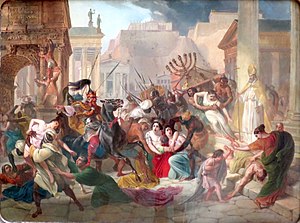Sack of Rome (455)
This article's lead section may be too short to adequately summarize the key points. (February 2021) |
| Sack of Rome | |||||||
|---|---|---|---|---|---|---|---|
| Part of the fall of the Western Roman Empire | |||||||
 Genseric sacking Rome, by Karl Briullov | |||||||
| |||||||
| Belligerents | |||||||
| Vandal Kingdom |
| ||||||
| Commanders and leaders | |||||||
| Gaiseric | Petronius Maximus † | ||||||
| Casualties and losses | |||||||
| Unknown | more than 400,000 civilians and defensors | ||||||
The Sack of Rome in 455 AD marked a pivotal moment in European history when the Vandals, a Germanic tribe led by King Genseric, invaded the city. The Vandals pillaged the city for two weeks, causing widespread destruction. The event, following the Visigothic sack of 410, shocked the Roman world and symbolized the decline and impending fall of the Western Roman Empire.
Background
In the 440s, the Vandal king Genseric and the Roman Emperor Valentinian III had betrothed their children, Huneric and Eudocia,[2] to strengthen their alliance, reached in 442 with a peace treaty (the marriage was delayed as Eudocia was too young). In 455 Valentinian was killed, and Petronius Maximus rose to the throne. Petronius married Valentinian's widow, Licinia Eudoxia, and had his son Palladius marry Eudocia to strengthen his bond with the Theodosian dynasty. Eudoxia, however, in revenge for her husband's murder and the usurpation of the throne, conspired with the Vandals against Maximus. This coincided with Genseric's ambitions, and the king of the Vandals proclaimed that the broken betrothal between Huneric and Eudocia invalidated the peace treaty. He sailed to attack Rome, landing at Ostia at the mouth of the Tiber.[3]
Sack
Before approaching the city, the Vandals knocked down the aqueducts. At the sight of the approaching Vandals, Maximus and his soldiers tried to flee, but he was spotted and killed by a Roman mob outside the city,[4] possibly together with his son Palladius. Upon the Vandal arrival, according to the chronicler Prosper of Aquitaine, Pope Leo I pleaded for mercy for the ancient city and its inhabitants. Genseric agreed and the gates of Rome were thrown open.[citation needed]
While Genseric kept his promise not to burn and slaughter, he did carry off some inhabitants as slaves, and also managed to capture Eudoxia and her daughters Eudocia and Placidia as they tried to escape.[5] Eudocia would later marry Huneric.[citation needed]
Aftermath

Genseric looted great amounts of treasure from the city, damaging monuments such as the Temple of Jupiter by stripping away the gilt bronze roof tiles, hence the modern term vandalism.[6][7] The fourteen-day sack of 455 is generally considered more destructive than the three-day Visigothic sack of 410.[8]
Assessment of the sack
Despite the popular image of Vandal destroyers, the severity of the sack is debatable, with claims that it inflicted little murder, violence, or arson. This interpretation seems to stem from Prosper's claim of the promise of leniency which Pope Leo I coaxed from Genseric. However, Victor of Vita records that several shiploads of slave captives arrived in Africa from Rome. The Byzantine historian Procopius reported the burning of a church.[citation needed] Some modern historians like John Henry Haaren maintain that temples, public buildings, private houses and even the emperor's palace were sacked.[9] The Vandals also took immense quantities of gold, silver, jewels and furniture, destroyed works of art, and killed a number of citizens.[citation needed]
References
Citations
- ^ Gwatkin, Henry Melvill; Whitney, James Pounder; et al. (1911). The Cambridge Medieval History. Macmillan. pp. 308.
On 2 June Gaiseric marched into Rome ... The Vandals stayed a fortnight...
- ^ Peter Heather, The Fall of the Roman Empire: A New History of Rome and the Barbarians, (Oxford University Press, 2006), 378.
- ^ Edward Gibbon, The Decline and Fall of the Roman Empire, (The Modern Library, 1932), ch. XXXVI., p. 1258.
- ^ Peter Heather, The Fall of the Roman Empire: A New History of Rome and the Barbarians, 378–379.
- ^ J.B. Bury, History of the Later Roman Empire (London: Macmillan, 1889), vol. 1 p. 235 f.
- ^ Encyclopædia Britannica, cited in Online Etymology Dictionary (13 ed.). Encyclopædia Britannica. 1926.
- ^ Peter Heather, The Fall of the Roman Empire: A New History of Rome and the Barbarians, 378.
- ^ Peter Heather, The Fall of the Roman Empire: A New History of Rome and the Barbarians, 379.
- ^ Genseric the Vandal King from 427–477 AD.
Sources
- Procopius, 'The Vandalic War' in The History of the Wars, Books III & IV, trans. H.B Dewing (Cambridge; Mass. 1916)
- Muhlberger, S., The Fifth Century Chroniclers: Prosper, Hydatius and the Gallic Chronicler of 452 (Leeds, 1990) — for Prosper's hagiographic portrayal of Leo.
- Victor of Vita, History of the Vandal Persecution, trans. J. Moorhead (Liverpool, 1992).
- Ward-Perkins, B., The Fall of Rome and the End of Civilisation (Oxford, 2005) pp. 17 & 189.
